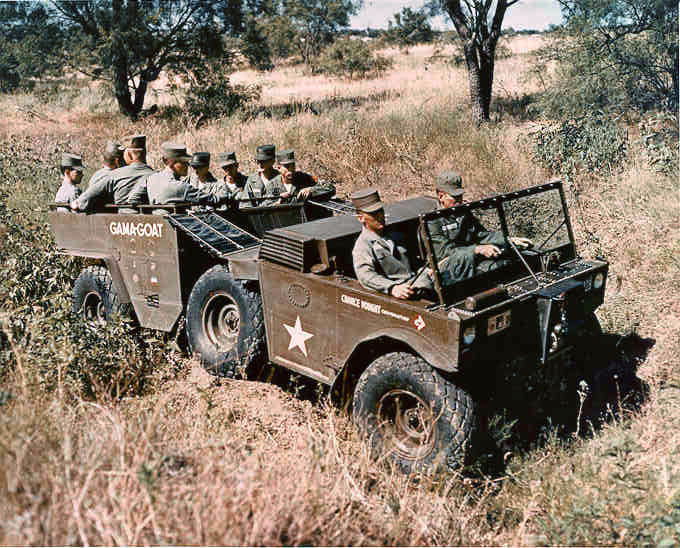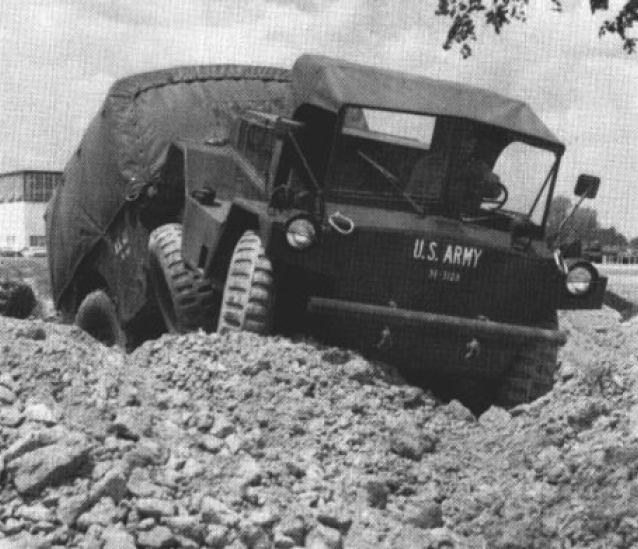M561 Gama Goat
 Chance vought 1+1/4-ton 6x6 (1969-1990),
Chance vought 1+1/4-ton 6x6 (1969-1990),
The Gama Goat was a six-wheel-drive semi-amphibious off-road vehicle developed spcifically to answer Vietnam theater needs, notably use in very difficult jungle terrain. The technical solution chosen was an articulated body, in a rather unique four wheel steering arrangement, front and rear wheels turning in opposite directions.
The unofficial name, which stuck, was composed of "Gama" (from Roger Gamount, father of the powered articulated joint) and "Goat" reflecting its mountain goat-like off-road ability. Army designation was "M561, 6x6 tactical 1.5-ton truck". The main ambulance variant was known as the M792;
Development

The design of the vehicle went far away before the Vietnam war. Right after WW2 in March 1947 Roger Gamaunt from Fawnskin, California, started to work on a perculiar truck layout based on an articulated body and three axles. At this stage, he drew inspiration of the classic arrangement of a 4x4 tactical truck towing a single axle trailer. The base was "what if the trailer was part of the ensemble, and powered as well ? What if instead of being a deadweight it was able to participate to the whole vehicle mobility, adding an unprecedented level of flexibility on all terrains.
However his concept was patented, but stayed on th drawing board. Indeed post-WW2 the Army did not needed such vehicle and was concent in using its classic 2x6 and 2x4 trucks, with the nex standard chosen being the M35. In January 1959, Chance Vought started its “Project Breakout” program, exploring ways to mix its manufacturing experience from the aircraft industry.
One such project was a "conveyor belt" automatic hotel cleaning process and in restaurants but the was not successful. The other was to propose a super-agile truck taking advantage of Gamont's patents, and started to work on the future Gama Goat. The company originally had two other military vehicle programs, both military vehicles. It's on July 23, 1959 that Roger Gamaunt and Chance Vought Corporation met, and the latter was persuaded to work for them, creating detailed layouts of suspension with roll tube assembly/casting for new reduced differential housings.

On October 2, the same year was signed between Gamont and Vought the "Contract CV288" for the manufacture a full scale prototype named already the "Gama Goat" to be delivered 10 months and one week to Vought as contracted with provisions of partial payments for Gamont's performance. It was to be evaluated by Chance Vought and if successful, return it to Gamaunt to be installed at F.O.B. Dallas, Texas. Vought loaned all equipment to Gamont, sent at his workshop at by Fawnskin and would provide technical assistance. Gamaunt would provide in exchange the licensing to manufacture and sell the completed vehicle under royalties. Chance Vought would pay for the global patent on the final Gama Goat, a patent acted on April 13, 1960, issued May, 1965.

In July 1960 Gamaunt's prototype was delayed, and decision made to return it for completion at Chance Vought in Grand Prairie, Texas. Problems came for a change in gear train, remanufacting major components notably the 3-speed Willy’s transmission and clutch, ditching the 4 speed Corvette gearbox. New differential gears were reordered. Long delays to obtain axles and wheels also played; To gain time the body would be fabricated at Chance Vought, completed and shipped by June. There was still the 24 October demonstration planned.
It included Chance Vought recommendations for improving the vehicle, notably the road clearance from 9 to 15 inches, tire size, 4-speed transmission and tailored transfer case with M-38 internal gears. The final two tanks cumulated 80 gallons fuel capacity at the front. The workshop announced the vehicle ready by 30 September 1960, first tests on 1 and 2 October and the contract was amended to integrated the changes, giving extra delays.
As the development went, a small team of Chance Vought engineers detached to California ensured the prototype would be completed in time, and modified with very few formal drawings. It should not be underestated how much influenced and ideas went into this concept. The idea of creating such a vehicle was in part based on the French army experience with WW2 US trucks in Indochina, not adapted to local topography.
 Trials 1965
Trials 1965
Construction
In 1959, the Advanced Research Projects Agency (ARPA) had the "Agile Project" to develop a new vehicle for the Southeast Asia theater and proposed a set of requirements and open competition. Clark Equipment, General Motors and LeTourneau competed. But ultimately Ling-Temco-Vought Aerospace argued it could built the vehicle at its Consolidated Diesel Electric Company (CONDEC) in Charlotte, North Carolina, and with the Gama Goat patent, won the competition, obtained production.
 Army rival AMC 166 comparative trials
Army rival AMC 166 comparative trials
It was however put in competition also with the tracked XM571 Articulated Utility Carrier later in the second turn, developed by Canadair Ltd. in Montreal, which lost. The Gama Goat R&D program cost was about $8.7 million. Vought delivered some 15,274 Gama Goats, at $8,000 each ($74,289 today), quite expensive even for the time. However, it did not prove to be the efficient and versatile vehicle so hoped for (see below). Its production ceased as soon as the construction contract ended.
Final construction at the Consolidated Diesel Electric Company (CONDEC), Charlotte, North Carolina started on 11 June 1968, with a 3-year contract for a final 15,274 vehicles split between the Army (13,516) and Marine Corps (1,758) a total contract worth $132.1 million. The engine was provided by Detroit Diesel, General Motors for $30 million also on 3-year. CONDEC's factories in Schenectady, New York, Greenwich, Connecticut also provided parts for the Gama Goat until production moved to Waterbury in Connecticut and the New York and Connecticut plants moved to Charlotte to be closer, and have access to cheaper labor, larger facilities.
Design of the Gama Goat
The M561 measured 226.6" or 5,756 mm or 5.76 m overall, for a width of 83.8" or 2,129 mm and an height 90.8" or 2306 mm, with a rigid box or tarp mounted, and a reduced height, frames down, of 65 inches or 1,651 mm. Its tread was 72 inches or 1,829 mm and ground clearance 15 inches or 381 mm. The pintle height was 22 inches or 559 mm. 5.76 m, weighs 3,300 kg and can carry 1,300 kg of payload. It was unarmed, apart a M60 Machine gun mount on the passenger fender, and personal weapons on board.
Mobility

The Gama Goat has a three-cylinder Detroit Diesel #3-53, two-stroke engine displacing 2,610 cc and for an output of 101 hp or 75-77 kW at 2,800 rpm and 217 lbf/ft (294 N/m) of torque. This enabled 90 km/h on road (56 mph). It was light enough to be air transportable and air-droppable. Although considered amphibious, it was limited to slow-moving waterways, propelled and steered by its 6 wheels. It had indeed a very low freeboard. Bilge pump was activated and the hull's drain openings were to be close as preparation but Buoyancy was poor and loads needed to be moderated. Most specialized variants were too heavy. Range, with the two fuel tanks, was limited to 420 km (680 km). The main option was a heavy self-unditching winch installed forward, making them even heavier.
 XM561 fording trials
XM561 fording trials
 In water fording trials c1965
In water fording trials c1965
 In difficult terrain, 1965
In difficult terrain, 1965
Now, in the nitty-grity of the beast, the Gama Goat angle of rotation on its longitudinal axis, central axle (2nde) relative to the body was ± 15° and of the rear part relative to the front part was ± 30° while its rotation, transverse axis, rear part relative to the front was ± 40°. It's approach angle (angle of attack) was 62° and exit angle of 45°, ventral angle, top was 140° and walkable step 18 inches or 45,7 cm.
It had twin superimposed triangles as suspensions combining L/R coil springs and L/R shock absorbers on the front axle, then half axles articulated middle, itself pivoting in relation to the body. There were transverse leaf springs there and L/R shock absorbers between wheel and the bridge as well as between the wheel and body.
On the rear axles, there were twin superimposed triangles with L/R coil springs and L/R shock absorbers and the direction was mechanical, unassisted.
There were forward, 1st axle and rearward, 3rd axle steering boxes, connected by universal joint transmission shafts, with the third axle countersteering simultaneously with respect to the first axle and to a lesser extent with a Gear ratio of 24:1 and a short 29 feet (8.84 m) tuning radius given the configuration, which was excellent considered their overall lenght.
Variants & Service
Base M561:
- Cargo/personnel (8 troops) carrier
- TOW ATGM team carrier. It was tested, not adopted, with its own TOW launching platform
- Communications set in a shelter installed in the cargo compartment
- Mortar carrier, bolted on the rear cargo deck.
- Short distance radar carrier for counter-mortar/artillery. No longer amphibious
- AN/MPQ-49 Forward Area Alerting Radar vehicle, installed rear cargo, same
There was no M561A1, but production model diverged as minor modificatiions took place, with a rounded engine hood and later angular one to simplify production and different louvres design.
M792:
This was the ambulance version, with the rear flatbed articulate section reconfigurated for stretchers.
The Gama Goat in action
Production took place from 1969 and thus, the first arrived after the Têt offensive, at a time activity against Viet-Minh and Viet-Congh never had been as intense. They soon proved their mobility was better than previous trucks in mountaineous terrain, but they left a lot to be desired. In muddy/swampy terrain blocked with interlocking branches and roots they just were stuck. They also proved underpowered, and broke down a lot. In fact reports were so alarming piling up in 1971, and by May 1972 Fort Hood examined 566 vehicles in workshops back in Vietnam and identified the following issues:
Defective brake drums, seals and "O" rings, seeping Water in differentials, Wheel brake cylinder leaking, Defective signal lights, Gear box low on oil, transmission leaking at dowel pins top cover, Loose wheel bearings, Transfer case oil pump inoperable, Transfer case jumps out of high range, Vent pipe missing on rear differential, Defective seat, tube, spindle assembly and Hood hinge broken. Many were related to manufacturing defects. The punishing combat conditions only exacerbated these issues.
 M576s piling up, decommisioned in the late 1980s
M576s piling up, decommisioned in the late 1980s
The Gama Goat saw after 1973 little action and was sent straight into reserves, sometimes even piling up literraly as covered hangars depots lacked. The ones still in action woth the USMC found action the last time during the Invasion of Grenada in 1983, both the M576 and M792 amnulace. The ones still around, replaced in the late 1980s by the Humvees (HMMWV) were found on the civilian market. Many were purchased by amateurs living in the wilderness or for collections, so they are still around today in rtelatively large numbers and often seen in auction. Some were used for forestry works, private sector, as well as for fire fighting in mountaineous regions of the United States.
Specs Chance vought M561 1+1/4-ton 6x6 |
| Dimensions (L-w-h) | 227 x 84 x 91 in (5.8 x 2.1 x 2.3 m) |
| Curb weight, battle ready | 7,275 lb (3,300 kg) |
| Crew | 1 driver, 8 passengers) |
| Propulsion | Detroit Diesel 3-53 160 cu in (2.6 L) Diesel I3 101 hp |
| Transmission | 6x6, 4-speed manual, 2x transfer cases, see notes |
| Top speed | 90 km/h (70 mph) road, 50 km/h (29 mph) off-road |
| Maximum range | 420 mi (680 km) |